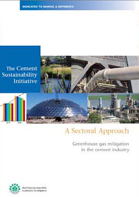Managing Cement's CO2 Emissions: A Sectoral Approach
 GLOBE-Net - The WBCSD Cement Sustainability Initiative (CSI) has released the results of an economic and policy modeling project designed to improve understanding of the impacts of different carbon policies on emissions reductions, global trade and regional market shares in the cement sector.
GLOBE-Net - The WBCSD Cement Sustainability Initiative (CSI) has released the results of an economic and policy modeling project designed to improve understanding of the impacts of different carbon policies on emissions reductions, global trade and regional market shares in the cement sector. The results of the study ( 571 kb) show that cement production is likely to more than double by 2030, based on current demand forecasts. As a consequence, emissions could increase significantly, albeit at a slower pace than cement production. Importantly, the trends could be strongly influenced by policy choices.
571 kb) show that cement production is likely to more than double by 2030, based on current demand forecasts. As a consequence, emissions could increase significantly, albeit at a slower pace than cement production. Importantly, the trends could be strongly influenced by policy choices.
A sectoral approach involves organized action by key members of a specific industry sector and their host governments to address the greenhouse gas emissions from their products and processes, within the UNFCCC framework. Specific actions taken would differ from sector to sector, taking into account the characteristics of each sector’s structure and technologies and the location of production facilities.
Actions taken would involve international cooperation (to develop agreed data, monitoring and verification requirements, identify best practices, and define possible crediting policies, etc.), coupled with nationally appropriate mitigation actions (NAMAs) at a country or regional level that would put effective mitigation tools into practice.
“Modeling different approaches, we found that global CO2 emissions might be reduced by as much as 25 percent under this sectoral approach, compared to a situation where there are no commitments to carbon reduction,” CSI program director Howard Klee said. “Reaching this level would necessarily involve engaging the world’s biggest cement producers and producing countries.”
“Today, 80 percent of cement is produced in developing countries. A clear advantage of this sectoral approach, which envisions a combination of emissions caps in developed countries combined with emissions efficiency goals in developing economies, is that it offers a policy structure that encourages efficiency gains without limits on economic development,” Klee added.
At the same time, international cooperation within a sector could offer a chance to focus on practical solutions, share and benefit from best practices, and participate in needed technology development.
More information:
Download


